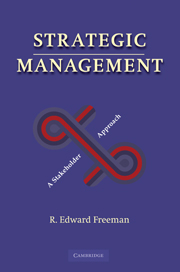Book contents
- Frontmatter
- PREFACE TO THE 2010 REISSUE
- Preface
- Contents
- Part I THE STAKEHOLDER APPROACH
- Part II STRATEGIC MANAGEMENT PROCESSES
- Four Setting Strategie Direction
- Five Formulating Strategies for Stakeholders
- Six Implementing and Monitoring Stakeholder Strategies
- Part III IMPLICATIONS FOR THEORY AND PRACTICE
- Bibliography
- Index
Four - Setting Strategie Direction
Published online by Cambridge University Press: 05 February 2015
- Frontmatter
- PREFACE TO THE 2010 REISSUE
- Preface
- Contents
- Part I THE STAKEHOLDER APPROACH
- Part II STRATEGIC MANAGEMENT PROCESSES
- Four Setting Strategie Direction
- Five Formulating Strategies for Stakeholders
- Six Implementing and Monitoring Stakeholder Strategies
- Part III IMPLICATIONS FOR THEORY AND PRACTICE
- Bibliography
- Index
Summary
INTRODUCTION
We begin with the analysis of how the stakeholder concept can be used to make Strategic management decisions. Strategic management is a continuous process, and even though discrete points in time must be chosen for the purpose of making a decision, it must be done year-round, not just during the yearly “planning meetings.” I will examine the issue of how direction can be set using the stakeholder concept, and in particular make clear that the concept is useful in looking at the role of an organization in society. The concept of “enterprise strategy” will be used to examine this societal issue. The concept of “stakeholder audit” will build on the enterprise strategy of a firm to enrich the understanding of corporate and business level strategy.
SETTING DIRECTION IN ORGANIZATIONS
One of the major contributions of the implementation of Strategic management has been that executives can examine where the firm is headed, what the nature of its businesses will be and how changes in direction can be made. In the early days of Strategic management this examination of direction was made via long and involved processes which contained lots of Steps and made nice flow Charts resulting in binders of data which were for the most part never used.
- Type
- Chapter
- Information
- Strategic ManagementA Stakeholder Approach, pp. 85 - 125Publisher: Cambridge University PressPrint publication year: 2010



